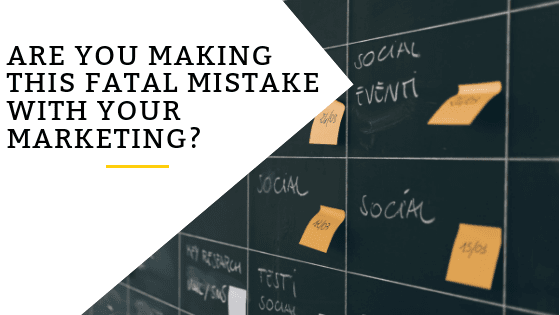Are You Making This Fatal Mistake with Your Higher Ed Marketing?
If you look at businesses, nonprofits, and universities that have had great success with their higher ed marketing and communication efforts, it’s because they’ve mastered doing one thing really well: they know how to tell a good story. Organizations like Apple, Starbucks, Patagonia, GoPro, Disney, Toms, and others understand that good storytelling is one of the best ways to reach their customers and win their trust. But it’s not just any type of story that wins a customer’s trust and engagement, but a certain type of story.
The story you tell has to actually matter to your audience.
What Does Storytelling have to do with Higher Ed Marketing?
Stories are intrinsic to our nature as human beings. Unlike fact-heavy lectures or presentations, stories have the ability to tap into the human spirit. They resonate with our emotions and values, often pointing to a deeper human truth. This is why we often remember things better when we hear them in a story. It’s why we tell our kids fairy tales: to teach them something about the world in a form that’s more entertaining and effective than merely telling them about it. Stories are so powerful that they can even save our lives.
A Fast Company article titled “Change or Die” featured a striking statistic uncovered by Dr. Edward Miller, the dean of the medical school and CEO of the hospital at Johns Hopkins University. He found that, within two years, 90 percent of people who have had coronary-artery bypass grafting surgery revert back to the same unhealthy habits that led to their heart disease in the first place. Despite their brush with death, the majority of these patients fail to make long-term changes to the pernicious habits that they could control.
But employing the techniques of good storytelling could actually change these discouraging findings; Dr. Dean Ornish, a professor of medicine at the University of California, San Francisco, has helped his patients make lasting lifestyle changes by encouraging them to imagine a happier future made possible by beneficial behavior. The use of their imaginations fueled their desire to maintain permanent changes much more effectively than those who were otherwise spewed facts about harmful and healthy behaviors. Dr. Ornish’s emphasis on story led to healthier, happier, and longer lives.
There’s no doubt that a journey is far more engaging than a statement. Audiences are captured by narrative, especially ones that chart the path to a resolution that they are invested in. And what better way to invest someone in a story than to put them at the center?
Who’s the Hero in Your Marketing?
A fatal mistake that most schools make with their higher ed marketing is that their stories are all about the school—what makes the school’s programs worth the sticker prices, the commitment and success of the faculty, or the service-oriented work the school is doing for the community. Of course, these things do matter to your audience and need to be communicated. But the problem isn’t that most schools are not communicating them; it’s that they’re not communicating them in the right way. What makes some schools stand apart from the rest is their commitment to place their audience—and not the school itself—at the center of the story they’re telling with their higher ed marketing and communication efforts.
Think of that person you meet at a party who is going on and on about how much money they make or how many luxurious destinations they frequent a year. The truth is that many schools come across like that insufferable party guest, only communicating how great their offerings are in a manner that is arrogant and, honestly, uninteresting. When it comes to your audience, they only want to hear about how your school can affect them in meaningful ways. Whether that’s providing them with a means to follow their career aspirations or financially support a mission they feel enthusiastic about, they want to know how your school can impact their own lives, dreams, and aspirations.
Now think about someone you meet at a party who takes time to ask you questions, demonstrates a genuine interest in your life, and connects with you by sharing their own experiences and stories. In the exact same way, it’s by modeling this type of communication that you make your audience trust your school and want to enter into a relationship with it. When the story you tell presents your school as the secondary character concerned with the success of your audience, it will compel them to engage your services with an understanding of how your school can impact their lives for the better.
Position Your School as the Guide
Every good story has a hero—a character we root for and want to succeed. And your audience is only going to be interested in your school’s story if they themselves are the hero of it. That’s what Apple did in the 90s with their “Think Different” campaign. People resonated with the campaign, as well as the story they heard, because Apple presented their customers as the hero within a narrative of individuality and uniqueness. In this story, Apple was merely the helpful “guide” that could equip the customer with technology to enable their self-expression and creativity.
The good news it that there is great potential for your school to tell a great story, as it offers a service that can drastically transform your audience’s lives for good. You aren’t selling toothpaste or vacuums, but rather an education that can lead to meaningful and fulfilling careers, national economic health, and greater civic engagement. And those are only some of the many ways your school impacts students, alumni, donors, and the community for the better. There are few services one can purchase that are as life-changing as a university education. That’s why your school has a story that your audience needs to hear—one in which you help them reach fundamental life goals and dreams. Who wouldn’t want to be part of a story like that?
Then how exactly do you speak to prospective students, parents, donors, faculty, employees, and other stakeholders with your higher ed marketing and communication efforts in a way that positions them as the hero and your school as the trusted and dependable guide?
By positioning your school as the helpful and knowledgeable “guide”—as opposed to the “hero” —you can communicate the value and benefit of your school in a proven way that captures your audience’s attention and ultimately wins their trust and engagement. This is a game-changing technique that can help you meet enrollment, fundraising, engagement, recruitment, retainment, and other institutional goals critical for success in today’s higher ed landscape.
The articles below each detail one aspect of how to elevate your school’s brand in the minds of your audience using a proven and easy-to-follow framework that puts them at the center of your brand’s story. These articles takes many of the concepts developed by best-selling author Donald Miller in his book Building a Story Brand and applies them to the world of higher education.
The Surprising Power of Empathy in Marketing
The Importance of Marketing with Authority
Using Testimonials in Your Higher Ed Marketing: Our 6 Tips to Success
By the Numbers: Winning Over Your Audience with Statistics
Third-Party Validation: Distinguishing Your School
How to Highlight Your School’s Partnerships to Win at Higher Ed Marketing
Why Your Higher Ed Institution Should Embrace Content Marketing





